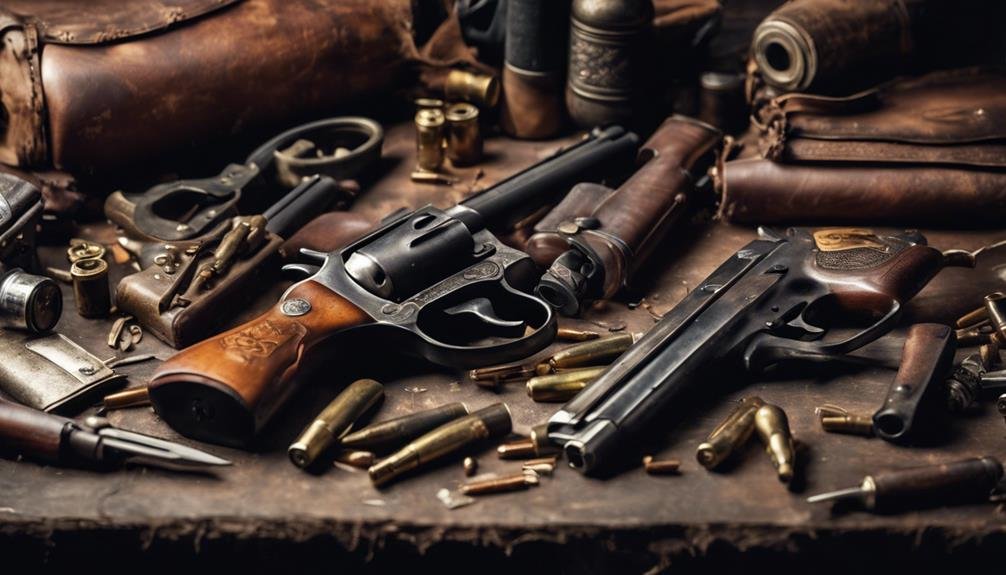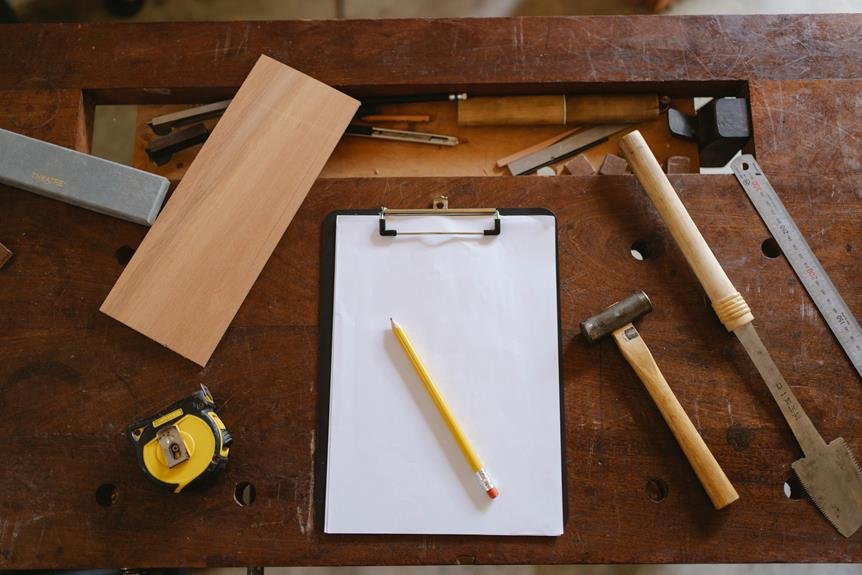Bonnie Parker and Clyde Barrow's notorious crime spree was fueled by a strategic arsenal of customized firearms that gave them a decisive edge over law enforcement. Their arsenal included three full-auto Browning Automatic Rifles, a 20-gauge Remington Model 11 semi-automatic sawed-off shotgun, and handguns, with over 3,000 rounds of assorted ammunition. These weapons were modified to suit their tactical needs, demonstrating their understanding of firearms evolution. The gang's superior firepower allowed them to evade capture and outmaneuver law enforcement at every turn. As the duo's crime spree unfolded, their arsenal played a pivotal role in their ability to stay one step ahead – but the question remains, what other secrets lay hidden in their deadly arsenal?
Key Takeaways
- The Barrow Gang's arsenal included full-auto M1918 BARs, semi-automatic shotguns, and handguns, giving them a decisive edge over law enforcement.
- The gang's firearms were modified to suit their needs, demonstrating their understanding of Firearm Evolution and tactical applications.
- The arsenal was a showcase of the Gun Culture of the time, with a collection of weapons pilfered from National Guard armories.
- Bonnie and Clyde's firepower advantage allowed them to outmaneuver law enforcement at every turn, evading capture for a prolonged period.
- The gang's superior firepower was a key factor in their notorious crime spree, enabling them to rob banks, gas stations, and stores with impunity.
Bonnie and Clyde's Deadly Alliance
Born in the dusty, desperate landscape of Texas, Bonnie Parker and Clyde Barrow forged a deadly alliance that would leave a trail of bloodshed and terrorize the American heartland during the Great Depression. As romantic partners, they defied the conventional norms, embracing a life of crime. Their criminal code was simple: take what they wanted, whenever they wanted. This deadly duo's notoriety grew with each heist, earning them a reputation as an infamous couple. Bonnie's poetry and Clyde's charm masked their ruthless nature, making them a formidable team. Together, they crafted a criminal empire, always staying one step ahead of the law. Their bond was unbreakable, a union of love and crime that would ultimately lead to their downfall.
The Barrow Gang's Crime Spree
With their arsenal of powerful firearms and customized vehicles, the Barrow Gang set out on a crime spree that would leave a trail of destruction and terrorize the Midwest. The gang's dynamics were built on a foundation of trust and loyalty, with Clyde and Bonnie at the helm. This cohesion allowed them to move swiftly and strike without warning, often targeting rural areas plagued by poverty, where law enforcement was scarce. The gang's exploits were fueled by a desire for notoriety and wealth, as they robbed banks, gas stations, and stores, leaving a trail of devastation in their wake. As their infamy grew, so did their arsenal, with stolen weapons and customized vehicles giving them a technological edge over their pursuers.
Firepower of the Outlaws
Clyde and Bonnie's arsenal, pilfered from National Guard armories and customized to meet their tactical needs, played a pivotal role in their ability to evade capture and outgun their pursuers. The gang's firepower was a key factor in their notorious crime spree, allowing them to outmaneuver law enforcement at every turn. With a gang mentality that prioritized firepower, they amassed an arsenal that included full-auto M1918 BARs, semi-automatic shotguns, and handguns. This superior firepower gave them a decisive edge over law enforcement, who were often outgunned and outmaneuvered. As a result, the Barrow Gang was able to maintain their freedom for as long as they did, leaving a trail of destruction and chaos in their wake.
Customized Arsenal of Doom
Three full-auto M1918 BARs, modified to accept 40-round capacity magazines, formed the backbone of Bonnie and Clyde's customized arsenal of doom. These modifications, likely done by a skilled firearm enthusiast, allowed the outlaws to loose a hail of bullets on their pursuers. The gang's arsenal modifications showcased a deep understanding of tactical advantages, demonstrating a keen awareness of firepower superiority. The BAR's 40-round capacity magazines, for instance, enabled sustained firepower in intense shootouts. Such arsenal modifications were a hallmark of the gang's criminal prowess, allowing them to stay ahead of law enforcement. The customized arsenal of doom was a demonstration of the gang's cunning and resourcefulness, making them formidable opponents in the dark alleys and dusty roads of the American heartland.
High-Powered Firearms Advantage
By the time Bonnie and Clyde's crime spree reached its peak, their arsenal boasted an array of high-powered firearms that gave them a decisive advantage over law enforcement. This marked a significant milestone in the Firearm Evolution of the American outlaw. The duo's arsenal was a demonstration of their cunning and resourcefulness, as they adapted and modified their weapons to suit their needs. The Outlaw Mythology surrounding Bonnie and Clyde was further solidified by their ability to outgun and outmaneuver their pursuers. With their customized BARs, sawed-off shotguns, and semi-automatic handguns, the Barrow Gang remained one step ahead of the law, fueling the public's fascination with their notorious exploits.
The Automobile Getaway Cars
With powerful engines and customized features, the V-8 Fords preferred by Clyde provided the Barrow Gang with the speed and agility necessary to evade law enforcement and facilitate their brazen heists. These getaway cars were the gang's lifeline, allowing them to outrun and outmaneuver pursuing authorities in high-speed car chases. As road warriors, Clyde and his crew relied on their souped-up Fords to escape danger and maintain their notorious reputation. The gang's expertise in modifying their vehicles with reinforced steel plates, bulletproof glass, and souped-up engines made them nearly untouchable on the open road. This deadly combination of firepower and horsepower enabled the Barrow Gang to stay one step ahead of the law, earning them a legendary status as the original road warriors.
The Gang's Tactical Advantage
Clyde's arsenal of modified firearms, including his cut-down M1918 BAR and Bonnie's sawed-off shotgun, gave the Barrow Gang a decisive tactical advantage over law enforcement, allowing them to outgun and outrun their pursuers. This strategic edge was pivotal to their crime strategy, as they exploited the limitations of police firepower. By employing battle tactics like ambushes and rapid retreats, the gang capitalized on their superior weaponry. The modified firearms enabled them to pin down law enforcement with suppressive fire, creating an opportunity for escape. This calculated approach to crime allowed the Barrow Gang to evade capture for an extended period, making them formidable outlaws of the Great Depression era.
Bonnie's Lethal Shotgun
Bonnie's trusty 20-gauge Remington Model 11 semi-automatic sawed-off shotgun, often carried at her side, packed a devastating punch in close-quarters combat, its shortened barrel and customized ergonomics making it an ideal weapon for surprise ambushes and rapid escapes. This sawed shotgun was a hallmark of Bonnie's resourcefulness as a female outlaw, adapting to the gang's needs with precision and stealth. The Remington's semi-automatic action allowed for rapid follow-up shots, while its compact size made it easy to conceal and maneuver in tight spaces. With a customized stock and grip, Bonnie's shotgun became an extension of herself, a deadly tool honed for the gang's high-stakes heists and getaways.
Clyde's Cut-Down Rifle
Modified to meet the gang's specific needs, Clyde's go-to firearm was a customized M1918 Browning Automatic Rifle (BAR) shortened to a manageable length, its 40-round capacity magazine and full-auto capability rendering it a formidable force in high-stress confrontations.
The modifications allowed Clyde to wield the rifle with ease, making it an extension of himself. This psychological advantage played a significant role in the gang's ability to intimidate and outgun their adversaries. The rifle's firepower psychology was a vital factor in the gang's success, as it instilled fear and hesitation in their enemies.
Some key features of Clyde's cut-down rifle include:
- A shortened barrel for improved maneuverability
- A 40-round capacity magazine for sustained firepower
- Full-auto capability for suppressive fire
- Customized stock and grip for improved ergonomics
Evasion and Ambush Tactics
The Barrow Gang's high-speed getaways and clever ambush tactics allowed them to evade law enforcement for as long as they did, exploiting the limitations of 1930s policing to stay one step ahead of their pursuers. The gang's evasion strategies relied on speed, surprise, and adaptability, using their arsenal to outgun and outmaneuver lawmen. Ambush tactics were a vital component of their evasion strategies, with the gang often lying in wait for unsuspecting police patrols. By adopting guerrilla-like tactics, the Barrow Gang could pick their battles, choosing when and where to engage with law enforcement. This cat-and-mouse game allowed them to stay one step ahead of their pursuers, prolonging their crime spree and cementing their notorious reputation.
The Outlaws' Arsenal Breakdown
Clyde's arsenal boasted an impressive array of firearms, including three full-auto Browning Automatic Rifles (BAR) in .30-06, which gave the gang a decisive firepower advantage over law enforcement during their notorious crime spree. This firepower edge played a significant role in their ability to evade capture for as long as they did. The gang's arsenal was a showcase of the Gun Culture of the time, showcasing the evolution of firearms and their tactical applications.
- The arsenal included three full-auto BARs, providing a significant firepower advantage
- A 20-gauge Remington Model 11 semi-automatic sawed-off shotgun was also part of their arsenal
- The gang had 100 loaded 20-round BAR magazines, some in bandoliers, and 3,000 rounds of other assorted ammunition
- The firearms were modified to suit the gang's needs, demonstrating their understanding of Firearm Evolution and its applications
The Final Showdown
As the law closed in on May 23, 1934, Bonnie and Clyde's notorious crime spree came to a bloody end in a hail of gunfire on a rural Louisiana road. The police, employing advanced tactics, had carefully set up an ambush, using their knowledge of gang psychology to anticipate the outlaws' movements. A team of six lawmen, armed with high-powered rifles, lay in wait, anticipating the duo's arrival. As Bonnie and Clyde's car approached, the officers opened fire, riddling the vehicle with over 130 rounds. The outlaws, caught off guard, were quickly overwhelmed, their arsenal of firepower no match for the coordinated police tactics. In the end, it was the law's strategic planning and understanding of the gang's psychology that brought an end to the infamous crime spree.
Frequently Asked Questions
What Was Bonnie's Occupation Before Joining Clyde's Gang?
Before joining Clyde's gang, Bonnie Parker led a dual life as a poet with vivid dreams and a waitress, serving coffee and scribbling verses in her spare moments, her creative aspirations contrasting with her mundane job.
Did the Barrow Gang Target Only Banks and Gas Stations?
Like a wildfire, crime patterns spread across the Midwest as the Barrow Gang's robbery motives shifted beyond banks and gas stations, targeting rural stores, with gang dynamics and heist strategies evolving to evade law enforcement.
Were the Gang's Firearms Modifications Illegal at the Time?
They modified firearms to circumvent 1934's National Firearms Act, which restricted certain weapons and imposed taxes; their gunsmithing ethics were questionable, as their illegal modifications violated emerging firearm laws.
How Did Bonnie and Clyde Transport Their Arsenal During Heists?
Bonnie and Clyde cleverly concealed their arsenal in hidden compartments and car trunks, utilizing customized vehicles with secret storage spaces to transport their weapons, allowing them to evade detection during heists.
Were Bonnie and Clyde the Only Violent Outlaws of the Great Depression?
Bonnie and Clyde weren't the only violent outlaws of the Great Depression, but their crime spree psychology and public enemy allure captivated the nation, distinguishing them from contemporaries like John Dillinger and Pretty Boy Floyd.
Conclusion
As the curtains closed on the Barrow Gang's reign of terror, their arsenal of doom lay silenced, a monument to the firepower that fueled their notoriety. The customized weapons, precision-tuned for mayhem, finally fell silent, their deadly harmony disrupted by the long arm of the law. The outlaws' guns, once the instruments of chaos, now slumber, a haunting reminder of the devastation they wreaked, their fury finally spent.









